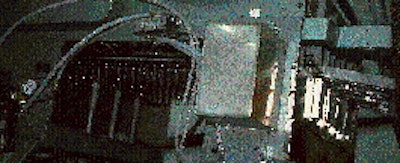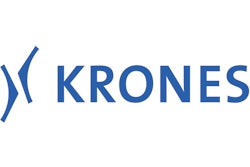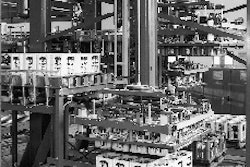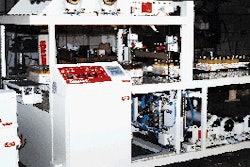Consolidation, joint ventures and partnerships continue to alter traditional supplier/packager relationships. Credit Schmalbach-Lubeca (Manchester, MI) and its customer AquaPenn Spring Water Co. for creating an insourcing partnership that's now saving the two nearly $1 million per year in total shipping costs. Polyethylene terephthalate bottle maker Schmalbach-Lubeca (formerly Johnson Controls) has provided PET bottles for AquaPenn for about eight years. Until this year, however, the supplier injection-molded PET preforms at one of its plants, sent them to another plant for stretch/ blow molding, then shipped the molded bottles to AquaPenn for filling. In late January, AquaPenn received the first bottles that Schmalbach manufactured at AquaPenn's Milesburg, PA, headquarters/bottling plant. Representatives from Schmalbach-Lubeca and AquaPenn tell Packaging World that this on-site container production partnership is a first for both. Normally, bottle molders locate nearby major customers for economic reasons. That was the case, for example, with Engepack Embalagens S.A., the Jundiai, Brazil, PET bottle molder, who built a plant close to customer Coca-Cola (see PW, August '97, p. 66). In this instance, Schmalbach-Lubeca leases space inside AquaPenn's Milesburg facility. The two companies have a five-year contract, according to Joseph Pollhein, Sr., Schmalbach- Lubeca's Milesburg plant operations manager. He says the first three years of the contract are mutually exclusive. AquaPenn has agreed to buy bottles only from Schmalbach, unless the bottle maker can't supply them for whatever reason. In the last two years of the contract, AquaPenn can entertain competitive bids. Ed Lauth, AquaPenn's president, chairman and founder, has been more than pleased with the arrangement. "We have an understanding and a commitment with Schmalbach-Lubeca, and it's a good relationship." Lauth says AquaPenn will sell "in excess of 100 million PET bottles of water this year." Sizes include a brand new 24.9-oz bottle (27 g), as well as 12-oz (24 g), 16.9-oz/1/2-L (24 g), 20-oz (27 g), 1-L (37 g) and 1.5-L (42 g) versions. An 8-oz bottle, introduced in January (see PW, March '97, p. 2) is still produced at another Schmalbach-Lubeca plant; however, plans call for it to be molded in Milesburg in the near future. Why insourcing? The partnership benefits both companies. From AquaPenn's perspective, it provides competitive and economic advantages. "Very few of our competitors mold on-site," says Lauth. "Only the really big dogs in the PET category do this. For us to stay competitive with them, the decision to mold on-site was a no-brainer." Particularly when cost is factored in. "The bottled water industry continues to create downward pricing pressure," explains Lauth. "If we're going to compete with the likes of Perrier and Evian, we're going to have to be a low-cost producer. The only way we can do that is to take out some of our internal costs." With its bottle volume, Lauth estimates AquaPenn saves about $750ꯠ annually by no longer paying freight costs for bottles molded at a distant plant. Now they're made on-site and delivered to staging areas for filling. Presumably, captive bottle molding by itself would have eliminated these shipping costs, so why did AquaPenn take the extra step of insourcing? First, there's the income it receives from leasing plant space to Schmalbach-Lubeca. Lauth says that income has financed a new plant addition that will partly be used for more bottle-making equipment. And since the bottle maker owns the equipment used to mold the bottles, there's no need for AquaPenn to invest in new equipment. With Schmalbach-Lubeca employees maintaining the machinery, there's no need for labor-intensive training for AquaPenn personnel. Having its bottle molder on-site also eases Lauth's concerns when it comes to having a dependable supply of bottles. "With this arrangement, we have a vendor that's 100-percent committed to us," he says. "Sure, there's no guarantee that we'll never have a shortage of PET bottles, but when the PET supply is tight, usually in the summer when we need bottles the most, a lot of companies might have to wait for bottles from off-site vendors. That limits their ability to ship finished goods to sell at retail. We believe our relationship gives us a tremendous advantage in having materials available so that we can ship bottles and move them onto store shelves. That is absolutely critical," Lauth contends. Supplier benefits, too "This [insourcing arrangement] is a first for our company," notes Schmalbach's Pollhein. "It benefits us for several reasons. First, we save more than $200ꯠ a year in shipping preparation costs. Before we had a person to coordinate shipping, track trucks, handle paperwork, and so on. Loads had to be transferred onto trucks and taken off trucks in Milesburg. All that goes away with this arrangement. Now we have one bill of lading and deliver pallet loads to a staging area." While Schmalbach-Lubeca does have to ship preforms to Milesburg, significantly more of them can be shipped in a single truckload than bottles, making them substantially more economical to ship than bottles. Preforms are shipped in gaylords, 48 gaylords per truck, which Pollhein says is economical. There's also the ability to immediately respond to AquaPenn's needs. By working together, there's more of an intimate sharing of knowledge of each other's needs. That has helped lead to some practical adjustments to improve efficiency. A recent example of this cooperation concerned the handling of bottles. Pollhein notes, "We knew that when bottles were shipped to Milesburg by truck, load height was restricted by the height of the truck. Here, we're only restricted by the stacking height capabilities of the palletizing equipment. We've worked it out so that the average pallet load of finished bottles for AquaPenn accommodates an extra layer of bottles compared to the trucks. That means we need fewer pallets, less strapping, corrugated, stretch wrap, storage space and handling. That saves labor and material costs." Expansion Schmalbach-Lubeca's New Castle, DE, facility injection molds bottle preforms from PET resin supplied primarily by Eastman Chemical (Kingsport, TN). AquaPenn's bottles are made from resin designated 9921W. Preforms are shipped to Milesburg, where 35 Schmalbach employees work within an area approximately 30ꯠ sq'. This area was scheduled to be expanded in August. The additional space for molding is part of an overall increase of 185ꯠ sq' at the plant, which is the last of AquaPenn's current three-phase growth plan previously announced by Lauth (see PW, June '96, p. 44). Phase I, completed in '95, saw the company move to Milesburg from a 27ꯠ sq' plant in State College, PA. On-site molding was the second phase. The plant will encompass 345ꯠ sq' once the current expansion is completed. Schmalbach-Lubeca uses four RHB-V reheat-and-blow stretch/blow-molding machines from Cincinnati Milacron (Batavia, OH) to make bottles from the preforms. While the machines are not new, they were rebuilt specifically for this application. The changes were made primarily to boost bottle output. Modified machinery Schmalbach-Lubeca hired B & G Products (Grand Rapids, MI) to rebuild the equipment. B & G rebuilt hydraulic cylinders, control valves and lines, as well as oven banks, bushings, stretch-rod assemblies, and other components on the machines. Pollhein says the machines were originally designed to produce four bottles per cycle. Since the machine cycled every four to five seconds, that amounted to 48 to 60 bottles/min. Now the machine cycles bottles in less than three seconds, or upwards of 80 bpm. The speed increase is attributable both to B & G's efforts, as well as some changes made by Schmalbach-Lubeca. "These changes were mostly software-related," Pollhein adds. "Programmable logic control gave us ways to improve processing factors for each AquaPenn bottle." While the changes upped output, speeds are no match for some of the newer molding equipment that's available. That begs the question, "Why not use the newer equipment for a company like AquaPenn whose volume continues to rise?" First, Pollhein notes, some of those machines "cost around $1 million each, and then you have to factor in the cost of the molds for the machine. We're talking about a relatively short-term relationship here [with the current contract]. What's the payback on equipment that costs $200ꯠ per machine like the RHB-V versus one that costs $1 million? With this equipment, you lower your initial investment and still meet the customer's needs." Pollhein adds, "Our business is based on how do we get the most bang for our buck, and utilize our assets to their fullest extent. Our asset base is made up mostly of RHBs, so by not having to build into our cost structure the cost of new equipment, the cost to the customer is less in the long run." He says the RHB-V "is the perfect platform for this application because it allows us to maintain a more even keel in terms of workforce and production. This is a cyclical business and we can anticipate production needs and build inventory to pull from during periods of heavy use. If we had newer, higher-output equipment, we could run up a large inventory in a short period of time, but then what do we do?" The equipment, says Pollhein, is also advantageous for changeovers. "Changeover was one of the reasons we put the RHB-V's in here instead of other equipment," he says. "We run about seven or eight bottle types, and our people are able to complete changeovers in two to six hours. To do that with one of the newer machines, you're looking at 12 to 14 hours," he believes. At this point though, Schmalbach-Lubeca tries to minimize the need for changeovers. As Pollhein explains, "What we do is run one bottle size on two machines, another bottle size on two other machines." J-I-T molding Preforms are automatically dumped from gaylord shippers into the preform hoppers of the four blow molders. They're carried by a rubber-belted incline conveyor to a "tumbler wheel" with four mechanical arms that spin. The wheel delivers one preform to each of four lanes where they descend into a loading device. This device pushes four preforms at a time (one from each lane) up into four collets positioned on an "ovenbar." Collets suspend preforms by their neckrings, preventing heat damage to the finishes. The collets rotate preforms for proper heating from the oven's quartz lamps. From the oven, preforms descend into a sled-like device, which Pollhein refers to as a "reach-and-take" assembly. This moves the four preforms to a picker blow pallet mechanism that delivers preforms to the blow-molding section of the machine. Molds close around the four preforms. A rod descends into each preform, stretching the heated material in a linear direction. Initially, low pressure air from the stretch rod begins to blow the stretched material out to the sides of the mold. A subsequent 500-psi air assist then completes the blow. Chilled water in the mold walls cools the bottles. The cycle completes as the molds open. The blow pallet indexes bottles out of the mold and into an eject station where bottles are mechanically ejected down four lanes onto a single-file conveyor. Bottles pass a leak detector as they single-file to an automated palletizer. Schmalbach-Lubeca employs two new palletizers at Milesburg, both from Sardee Industries (Oak Brook, IL). Each palletizer accommodates production from two molding machines. Bottles are palletized in layers separated by slip sheets. A sheet is placed on top of the load, which is then strapped and stretch wrapped. Depending on AquaPenn's production needs, pallet loads may be stored or transported directly to staging areas upstream of filling lines. AquaPenn then fills, caps and labels bottles, as it had before insourcing. Bottles are shipped to retail customer distribution centers or distributed through brokers. Forecasting the future Packaging line improvements and product introductions continue on a regular basis at AquaPenn. At press time, the company was working with Schmalbach-Lubeca to lightweight its bottles, which would further reduce costs. "We're working with Schmalbach to start to lightweight the bottles," Lauth says. "We're in position to radically reduce gram weights because of the electronic valves on our filling Bloc system from Krones. " On the rotary filler, from Krones (Franklin, WI), 60 electronically triggered valves are used. "Valves open and close electronically compared to standard bottling equipment used in our industry that requires the strength of the container to actuate the valves," Lauth notes. "I think by next spring we'll be on the market with lighter-weight bottles." Peering further into the future, Lauth says, "I think the long-term goal for us would be to mold bottles ourselves, using preforms from Schmalbach-Lubeca. If and when we decide to mold ourselves, we'd look at newer high-speed blow-molding equipment." At this time, Lauth doesn't believe AquaPenn would injection-mold preforms in-house. "Preforms are usually made in such huge quantities that I think we'd have to be producing in the hundreds of millions of bottles a year to economically justify investing in the necessary equipment." For now, Lauth is satisfied with AquaPenn's insourcing arrangement. "We've been working with Schmalbach/Johnson Controls since day one," he recalls. "Not only are they competitive in price, they've also helped us through some tough times. When AquaPenn was on the ropes, they kept bottles coming. There was no question in our minds that we wanted them with us when we initiated on-site molding."






























